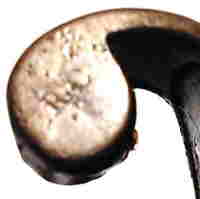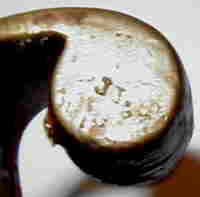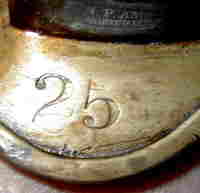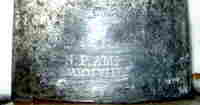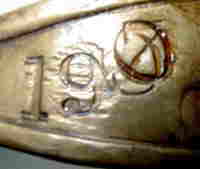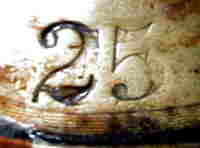| A
VETERAN QUARTET
101 YEARS BEFORE THE MAST U.S.
NAVAL CUTLASSES From left to right: Starr Contract of 1816, U.S. Model 1841, U.S. Model 1860, U.S. Model 1917 |
 |
|||||||||
|
|
||||||||||
| Recruit Number 1: The Nathan Starr Contract of 1816 | ||||||||||
 |
||||||||||
| This was Nathan Starr's third contract for naval cutlasses. The first two were the contracts of 1799 and 1808. There would be one more Starr model after this one - the contract of 1826. 1,000 of the 1816 model were contracted for by the United States government. | ||||||||||
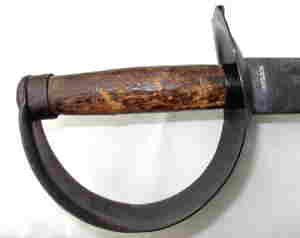 |
The marking on this cutlass are few. "N. STARR" in incised letters horizontally across the obverse side of the blade just above the hilt and on the very top of the single edged blade there is a "VIIIII", matching the thickness of the blade, starting about 1¾" above the hilt. | |||||||||
 |
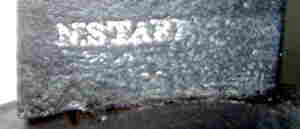 |
|||||||||
| The overall measurement of the weapon is 30¼". The blade is 1¼" wide at the guard and 24-7/8" in length with a narrow fuller of approximately 19". The hilt portion is 5-3/8". The wood barrel shaped grip has ½" iron ferrules at the top and bottom. The iron japanned black guard has turned out edges with a small curled over quillon. No scabbards were called for in the contract. They were apparently, when used, carried in the belt or sash. | ||||||||||
|
|
||||||||||
| Recruit Number 2: The Model 1841 | ||||||||||
 |
||||||||||
| The Navy Department adopted this new pattern cutlass in 1841 and signed a contract with Ames Manufacturing Company in 1842 to initiate production. It was similar in design to the model 1833 foot artillery sword, both being excessively heavy and unwieldy. The weapon pictured was produced in 1846. | ||||||||||
| There are several markings on this cutlass. On the obverse side of the blade, there is an "U.S" over a date of "1846." centered horizontally just above hilt. The maker's name, "N.P.AMES" over "CABOTVILLE" is on the reverse opposite the date. On the the obverse of the curled over quillon disc is the inspector's initials of "J L " and on the reverse is "R C." Additionally, on the the bottom of the guard there is a "25" stamped in the brass guard, adjacent to the blade, on both sides of the guard. Another number, "190" has been stamped over a previous number, on the outside near bottom of the guard. Pictures of these markings follow: | 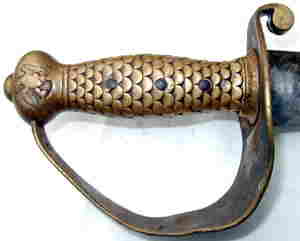 |
|||||||||
|
||||||||||
|
|
||||||||||
| Recruit Number 3: The Model 1860 | ||||||||||
 |
||||||||||
| Coinciding with the beginning of the Civil War, the Navy Department adopted a new cutlass inspired by a model long used in the French navy. It would stay a standard for U.S. sailors for the following 75 years, continuing to be found on board ships at and during WWII. This was despite the introduction of the Model 1917 (see following). When I went to my son's graduation from boot camp in 1977, the Model 1860 cutlass, now chrome plated, was proudly carried by the platoon leaders during the ceremony. Those blades would have been around for a 111 years at that time! Here's mine: | ||||||||||
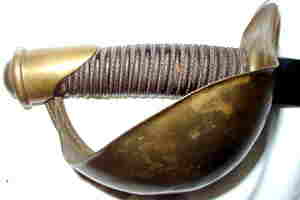 |
This cutlass has 5 markings of note. The obverse side of the blade is stamped "U.S.N" over "D.R." over "1862", horizontally just above the hilt. On the reverse side of the blade is the remains of "AMES MFG CO / CHICOPEE / MASS", within a scroll. The inspector's initials, "D.R." are stamped on top of the pommel ridge . There is also stamped on top of the counter guard a "2" over "164" and at the inside bottom of the guard is "5" over a "--" , over "3." | |||||||||
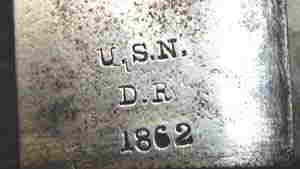 |
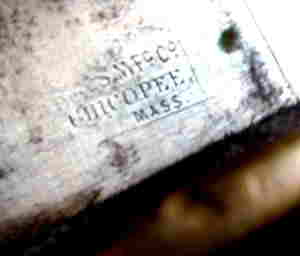 |
|||||||||
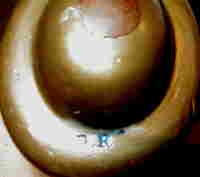 |
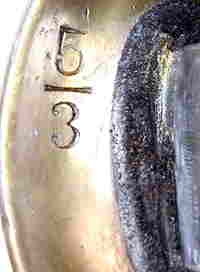 |
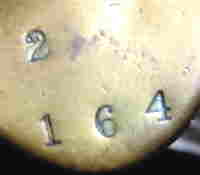 |
|
The overall length is approximately 32". The slightly curved blade
is 26" long and 1-3/16" wide at the hilt. There is wide fuller that
extends for 19½". The grip is wood covered by leather and
is wound with twisted brass wire. The pommel is helmet shaped. The
knuckle bow expands into an elliptical counter guard as it crosses
the blade. The counter guard is riveted to a large brass plate that
is shaped to form a solid half basket guard.
The black leather scabbard is fastened on the reverse side with a row of brass rivets. The obverse side features a brass stud for attachment to a belt frog. |
||
|
|
||
|
|
|

|
|
| According to Harold L. Peterson, author of "The American Sword - 1775-1945, in 1917, the Navy offered a contract to Ames for a new cutlass. However, Ames was not interested and the new cutlasses were apparently made by the Navy itself with production beginning in the spring of 1918. The number made is unknown, although it is thought to be low. It is also not known if they were ever issued for service. | |
| The only marking on this cutlass is a rather large "U.S.N." stamped or incised on the obverse side of the blade just below the hilt. The marking is unique as it is read with the blade pointed downward whereas the others read with the blades pointed upward. |
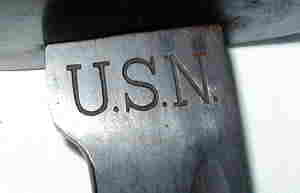
|
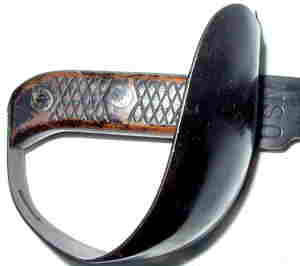
|
The overall measurement of this weapon is 29-7/8". The single edge blade measures 24¾" from the hilt to the end of the clipped point. It is 1-3/8" wide at the hilt for about ¾". It then curves upward with the rest of the blade being 1-3/16" in width. The blade is curved similar to the Model 1860. There is a 5/16" wide fuller approximately 14½" long. The wood grip consists of 2 pieces, with an incised diamond like pattern. It is fastened to the tang with 3 copper rivets. A single sheet of iron is cut to form a solid half basket shape. A large screw at the pommel fastens the metal basket to the grip. All of the metal, including the blade, is blued with the grip being painted black. The 25-1/8 long', 1-9/16" wide brown leather scabbard has a blued iron tip 5-1/8" long. The throat is a double thickness of leather with a 5/8" "U" shaped blued metal reinforce over it that is fastened to the leather throat with 2 rivets on each side. There is no frog stud on this scabbard and no evidence of there ever being one. |
|
|
|
| These are 4 of the 5 Navy veterans that I have. The 5th is a variant of the 1917, probably made around WWII. It is unmarked except for a "U.S." on a holed scabbard tab that was used for attaching to a belt frog. That weapon is without history, except they were sold as surplus after WWII with most ending up in Indonesia where the natives are probably still utilizing them. | |
|
Dave
Radcliffe
|
